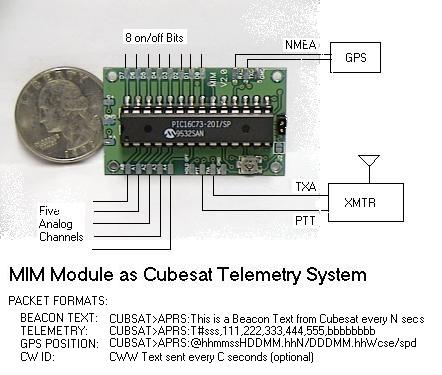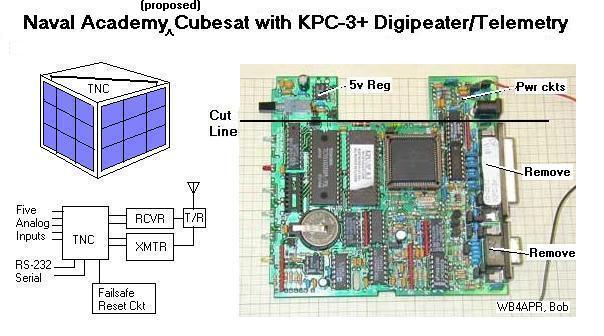USNA CUBESAT Notes

Bob Bruninga, WB4APR, Naval Academy Satellite Lab
USNA CUBESAT Notes

Bob Bruninga, WB4APR, Naval Academy Satellite Lab
Cubesats were pioneered by Bob Twiggs at the Stanford Small Satellite Labs and later explored by DOD with MEPSI, and Others. Cubesats offer a unique opportunity to get small student satellite payloads into space. Although the Cubesats are limited to a 4 inch cube, there are still lots of useful payloads that can fit into this space. Some suggested ideas for Payloads that we can build are the following:
Of course, every Cubesat needs a Telemetry, Command and Control system, and finding a small off-the-shelf solution was one of our first priorities. The following pages suggest two simple solutions to this Telemetry and Command requirement using the ubiquitous AX.25 amateur radio data standard. AX.25 can be received by hundreds of thousands of amateur radio operators worldwide. :
The MIM Module: The simplest Telemetry module is the MIM module shown below which provides for multiple periodic AX.25 packets at 1200 baud AFSK. Different rates can be set for the BEACON, Telemetry, GPS position and CW Identification. The module has no comand and control capability, but that is easily added with CTCSS or DTMF receivers/decoders in about the same size package.

1200 Baud TNC: The second and much more capable telemetry is the use of a Kantronics KPC-3PLUS TNC carved down to fit within the four inch cube. As can be seen in the photo below, the board will fit diagonally if the connectors are removed and the power supply portion of the board are relocated. This gives the same Telemetry, Beacon, GPS and CW ID capability as with the MIM module, but includes a full TNC DIGIPEATER and 4 channel COMMAND/CONTROL channel as well. With the full TNC, a complete digital communications transponder mission, such as PCSAT, can be supported. PCsat is just one of a possible constellation of student built satellites supporting the ASTARS Mission.

The ASTARS Mission is a generic mission to provide real-time message, position, and status relay via satellite to a worldwide internet linked amateur radio tracking system. Any amateur or university payload can support this mission by simply enabling DIGIPEAT ON on an AX.25 compatible transponder. The users of such a system can be for Boats at Sea, cross country travelers, expeditions, or any other travelers which are far from any existing APRS terrestrial tracking infrastructure. The satellite downlink from such travelers would be fed into the existing worldwide internet linked APRS system by a few permanent ground stations. This dedicated APRS satellite would join our own PCsat, The South African SUNSAT and several other on-orbit experiments that have been conducted over the years to demonstrate this capability.

The photo above shows the Kenwood digital packet radios that can be used as the ground user equipment to communicate via these ASTARS compatible satellites. The more of these satellites we can get into orbit, the more continuous the coverage provided to the users.
The Space segment of PCsat/ASTARS has been demonstrated a number of times in space via MIR School tests, the Shuttle SAREX, and the SPRE mission. . It is also a spin off of an previous launch opportunity that we had in 1998 called NATSweb that almost got launched on SEA-LAUNCH.. PCsat is a project to produce a viable spacecraft in a very short time frame using off the shelf components where possible. Here are the background topics of design:
APRS is the Automatic Position Reporting System that the Naval Academy uses for tracking its boats and a variety of other vehicles and networks using the APRS Automatic Position Reporting System . The Satellite described here in would be operated under the rules of the Amateur Satellite Service and the rules of the FCC. Although the satellite would be developed as a proof of concept for the Naval Academy, it would be available for all radio amateurs and their vehicles.
Other Cubesat WEB pages:
You are visitor:
.
|
|
|